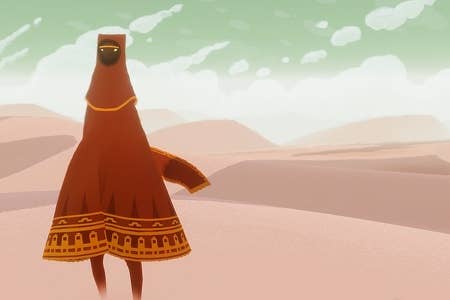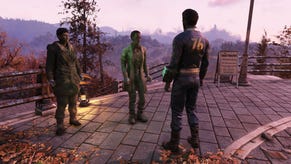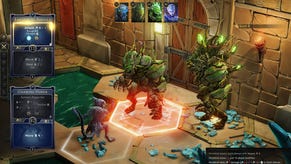Critical Consensus: Journey
Break out the thesaurus - thatgamecompany's latest will put your critical vocabulary to the test
Video game critics live to regret their reviews of games like Journey. Indeed, thatgamecompany's releases to date seems custom-built to lead the press down endless, winding avenues of purple prose: deliberately minimalist and aesthetically beautiful, flOw and Flower left acres of room for players to project their thoughts and feelings on the experience. The problem critics face is how to project those thoughts and feelings onto the page in a way that serves their readers rather than their own need to let the adjectives fly.
Joystiq's Jordan Mallory starts his five-star review with the definition of an adjective: awesome; a word, he argues, that is misused so often in the modern world that its true meaning has been lost. Fortunately, Dictionary.com is at hand to offer some clarity: "an overwhelming feeling of reverence, admiration, fear, etc., produced by that which is grand, sublime, extremely powerful, or the like."
"Nowadays, 'awesome' functions as a synonym for 'cool' or 'impressive'. When someone says a game is awesome, they're really saying that it's great, and generally are not implying any existential or emotional significance beyond that."
"I bring this up, because I don't want to be misconstrued as generic or uninspired when I say that Journey is an awesome game. In the most classical, archaic sense of the word, Journey is a beautiful, evocative and unequivocally transcendental experience."

So Journey is pretty good, then, and its current Metacritic average of 92 suggests that almost the entire gaming world feels basically the same way. That includes Eurogamer's Christian Donlan, who is open in his admiration for the way thatgamecompany implements classic design techniques with style and originality.
If Journey is mesmeric on your own, it's a revelation with a partner. These vast expanses are much easier to traverse with two
Chris Schilling, Videogamer
"That glowing mountain on the horizon is a case in point," he says in his 9 out of 10 review. "It seems like a straight lift from the Old Testament at first, but in Journey it's also your ultimate objective. It's both goal and waypoint marker, far less artificial than the breadcrumb trails of Perfect Dark Zero or Fable 2, but no less effective when it comes to the simple, crucial things that a game has to do - like keeping its players oriented as they move through large, artfully empty environments."
"Or check out the scarf that billows and flaps around your devout and pin-legged avatar as you lean into the wind. It's part of a distinctive moth-brown uniform that comes teasingly close to referencing religious garb as varied as the burqa or a Franciscan's habit, but it's also there to tell you how much magical energy you have left for jumping and floating."
"It's a piece of standard UI, essentially, yet it's stuck right into the game world, tracing pretty little spirals in the desert air as form and function merge."
Donlan touches on crucial aspects of thatgamescompany's work. Flower and flOw may have been zen-like counterpoints to the sturm und drang of the average video game, but they also adhered closely to classic tropes. In Flower you had to collect items to access the next area, while flOw played like Pacman in the Primordial Soup. Their originality lay in the execution more than the ideas; thatgamecompany's brilliance lies in its understanding of where to let the player fill in the gaps, and the powerful impressions that a lack of authored elements can elicit.

"The storyline leaves much to your own interpretation: you wake, alone, in the desert, and must then head towards a glowing peak in the distance.," Donlan continues. "Everything beyond that is what you make of it. Yet the game's mechanics waste no time at all explaining exactly what you should be doing from one moment to the next."
"Journey has room for physics challenges, stealth sections, and even some gentle levelling up as you collect tokens that allow you to hover in the air for longer periods of time. But it does all of this with an unusual economy of control - you're basically limited to move, jump, float and, um, sing."
Journey is a resolutely linear game in which your range of interactions is minimal. For some, that will make it a pretty but hollow novelty
Edge magazine
Journey's singing mechanic exists as a means of communication between players, but, true to form, thatgamecompany's implementation of multiplayer is unique. There are no separate modes, no challenges specifically designed for two, but every now and then the game will allow your journey to overlap with that of another player. You will spot them somewhere on that vast horizon; their companionship is entirely optional, but Videogamer's Chris Schilling describes the impact as akin to having "two games in one."
"If Journey is mesmeric on your own, it's a revelation with a partner," says Schilling, who also awards the game 9 out of 10. "That early reticence to engage will dissolve as you realise that these vast expanses are much easier to traverse with two. A jab of the circle button from either player sends out a noise that sparks the other's inner powers, and instead of trudging slowly across hilly dunes, you'll glide over them."
"In an arena dominated by conflict, it's an astonishing achievement to imbue players with the desire to co-operate. And not just to co-operate, but to co-habit, to share this bizarre, beautiful experience... Alone, you feel lost, fragile; together, you're empowered. You may have experienced similar in the silent but unbreakable bond of friendship found in Ico. But never quite like this, never with another player."

Edge magazine is less kind with with its score, though you'll have to read through 8 paragraphs of glowing praise before you find any negativity. Like so many others, the Edge hive-mind is full of admiration for the sparse beauty of the art direction, the ingenious subtlety of the level design, and the powerful effect of making your way with a partner in tow.
But this is Edge, and the score is 8 out of 10, so there must be flaws, even if they are described as little more than "niggles."
"The presence of collectible glyphs and hidden tapestries add a faint collect 'em all mentality to a game that's better without them - Journey's environments feel like they're designed to pass by in a dreamlike haze, not to be scoured for content. And some players will bemoan its relative brevity, coupled with the lack of incentive the game gives them to return. The problem with building a game around the magic of discovery is that it's a one-time enchantment."
"But Journey's real issue, if it has one, goes much deeper than that. It's a resolutely linear game in which your range of interactions is minimal. For some, that will make it a pretty but hollow novelty; boring, perhaps. But for those who play games to explore strange lands, see beautiful sights and to immerse themselves - for however brief a time - in a new world, Journey is perfect. And what's more, they'll find someone like them to share it with."









